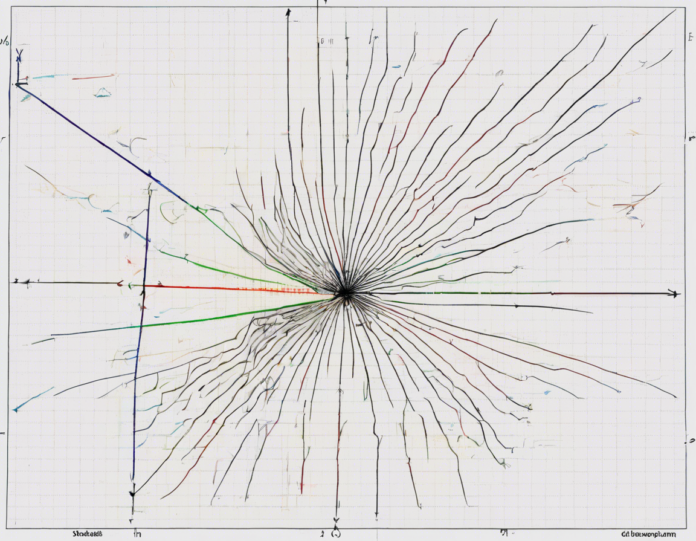Understanding how light moves and interacts with different surfaces and materials is crucial in the study of optics. One effective way to visualize the behavior of light rays is by drawing ray diagrams. These diagrams provide a simplified representation of how light rays travel, reflect, refract, and form images. In this article, we will delve into the world of ray diagrams, discussing what they are, why they are important, and how to draw them effectively.
What is a Ray Diagram?
A ray diagram is a graphical representation of the path that light takes as it travels from one medium to another or interacts with different optical elements such as mirrors and lenses. It is a useful tool in understanding and predicting the behavior of light rays in various optical systems. Ray diagrams typically involve tracing the path of at least two light rays to determine where they intersect and form an image.
Importance of Ray Diagrams
Ray diagrams are essential in the field of optics for several reasons:
-
Visualization: Ray diagrams provide a visual representation of how light rays interact with optical elements, making complex optical systems easier to understand.
-
Predicting Image Formation: By tracing the paths of light rays, one can determine where and how an image will be formed by a mirror or a lens.
-
Calculating Parameters: Ray diagrams help in calculating important parameters such as image location, magnification, and focal length.
Components of a Ray Diagram
A typical ray diagram consists of the following components:
-
Object: The object is the source of light rays that are being considered in the diagram.
-
Principal Axis: An imaginary line perpendicular to the surface of the optical element (mirror or lens) through its center.
-
Focal Point: The point where parallel light rays either converge (for a converging lens or concave mirror) or appear to diverge from (for a diverging lens or convex mirror).
Drawing Ray Diagrams: Step-by-Step Guide
Drawing a ray diagram involves following a set of steps to correctly represent the path of light rays. Here is a step-by-step guide to drawing a ray diagram for both mirrors and lenses:
Ray Diagrams for Mirrors
-
Identify the Object: Determine the position and size of the object you want to draw a ray diagram for.
-
Draw the Principal Axis: Draw a straight line perpendicular to the mirror’s surface passing through the mirror’s center.
-
Locate the Focal Point: For a concave mirror, the focal point is behind the mirror, while for a convex mirror, the focal point is in front of the mirror.
-
Draw Incident Rays: Draw at least two incident rays from the object towards the mirror. One ray should be parallel to the principal axis and reflect through the focal point after hitting the mirror. The other ray should pass through the focal point before reflecting parallel to the principal axis.
-
Locate the Image: The intersection point of the reflected rays is where the image is formed.
Ray Diagrams for Lenses
-
Determine the Object: Decide on the object’s location and height with respect to the lens.
-
Draw the Principal Axis: Similar to a mirror diagram, draw a straight line perpendicular to the lens passing through its center.
-
Identify the Focal Points: For a converging lens, the focal point is on the opposite side of the object, while for a diverging lens, the focal point is on the same side as the object.
-
Draw Incident Rays: Draw at least two incident rays from the object towards the lens. One ray should pass through the center of the lens without deviating, while the other should pass through the focal point before emerging parallel to the principal axis.
-
Locate the Image: The point where the refracted rays intersect is where the image is formed.
Tips for Drawing Accurate Ray Diagrams
To ensure accuracy and clarity in your ray diagrams, consider the following tips:
-
Use a Ruler: Straight and precise lines are essential for a clear representation of light rays.
-
Label Important Points: Clearly label the object, focal points, and optical elements to avoid confusion.
-
Be Consistent: Follow a consistent method for drawing rays, such as using different colors or styles for incident and reflected/refracted rays.
-
Check for Errors: Double-check your diagram to ensure that the rays are accurately traced and intersect at the correct points.
Frequently Asked Questions (FAQs)
-
What is the difference between a real image and a virtual image?
-
A real image is formed when actual light rays converge at the image point, whereas a virtual image is formed when the rays appear to diverge from the image point.
-
Why do we use ray diagrams in optics?
-
Ray diagrams provide a visual representation of how light rays interact with optical elements, helping in understanding image formation and optical behavior.
-
Can ray diagrams be used for complex optical systems?
-
Yes, ray diagrams can be used for complex systems by sequentially tracing the paths of light rays at different optical elements.
-
Do ray diagrams account for factors like dispersion and aberration?
-
Ray diagrams typically simplify optical phenomena and may not account for factors such as dispersion and aberration in detail.
-
What are some limitations of ray diagrams?
-
Ray diagrams are based on geometric optics and may not accurately predict phenomena such as wave interference and diffraction.
In conclusion, drawing ray diagrams is a valuable skill in optics that aids in visualizing and analyzing the behavior of light rays in different optical systems. By following the steps outlined in this article and practicing consistently, you can enhance your understanding of image formation, focal points, and the principles of geometric optics.




